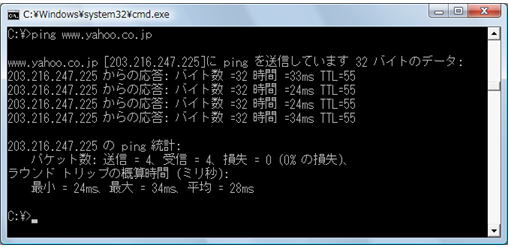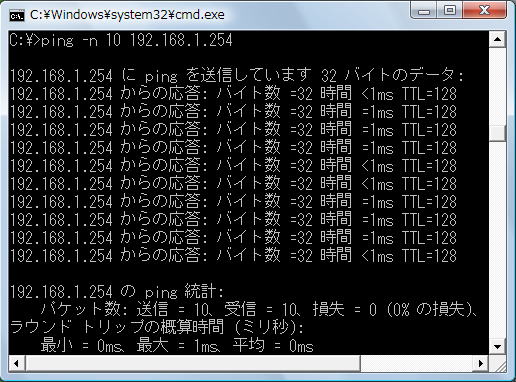pingコマンド
pingは、接続相手とのネットワーク疎通を確認する際に使用するコマンドです。
このpingコマンドを使用することにより、到達可能であるかどうかだけでなく、様々なエラーに対応するステータスを確認することができます。また、統計値を確認することでネットワークの輻輳状態を簡単に計測することもできます。
ping では、まずICMPのタイプ8のエコー要求(Echo)を宛先に送ります。これを受け取った宛先の端末は、ICMPのタイプ0ののエコー応答(Echo Reply)を返すようになっています。
※ただし、エコー要求(Echo)は、経路の途中や、PC上のファイアウォールでブロックされている場合があるので、必ず返事が返ってくるとは限りません。
送信元は、このエコー応答を受け取ることによって、通信が可能であるかどうかを確認することできます。エラーの場合には、エラーメッセージから、なぜ、宛先に到達できないのかを知ることができます。
Windowsの場合の ping コマンドは、コマンドプロンプト上から実行します。使用方法は以下の通りです。
Windowsの場合
| 【使用法】 ping [-t] [-a] [-n 要求数] [-l サイズ] [-f] [-i TTL] [-v TOS][-r ホップ数] [-s ホップ数] [[-j ホスト一覧] | [-k ホスト一覧]][-w タイムアウト] [-R] [-S ソースアドレス] [-4] [-6] ターゲット名 |
例えば、「www.yahoo.co.jp」への ping の実行例は、下図のようになります。

ping コマンドのオプション
| オプション | 説明 |
| -t | 中断されるまで、指定されたホストを Ping します。 統計を表示して続行するには、Ctrl+Break を押します。 停止するには、Ctrl+C を押してください。 |
| -a | アドレスをホスト名に解決します。 |
| -n 要求数 | 送信するエコー要求の数です。 |
| -l サイズ | 送信バッファのサイズです。 |
| -f | パケット内の Don't Fragment フラグを設定します (IPv4 のみ)。 |
| -v TOS | TOS Type Of Service (IPv4 のみ) です。 |
| -r ホップ数 | 指定したホップ数のルートを記録します (IPv4 のみ)。 |
| -s ホップ数 | 指定したホップ数のタイムスタンプを表示します (IPv4 のみ)。 |
| -j ホスト一覧 | 一覧で指定された緩やかなソース ルートを使用します。(IPv4 のみ)。 |
| -k ホスト一覧 | 一覧で指定された厳密なソース ルートを使用します。(IPv4 のみ)。 |
| -w タイムアウト | 応答を待つタイムアウトの時間 (ミリ秒) です。 |
| -R | ルーティング ヘッダーを使用して逆ルートもテストします。 |
| -S ソースアドレス | 使用するソース アドレスです。 |
| -4 | IPv4 の使用を強制します。 |
| -6 | IPv6 の使用を強制します。 |
オプションを指定したコマンドの使用例は、次のようになります。
C:\ping -n 10 192.168.1.254
デフォルトでは、送信するエコー要求の数は、4回ですが、ここでは、10回を指定しています。

ping コマンド(エラーメッセージ)
ここでは、Destination Unreachable(Type3)のエラーについて説明して行きます。
IP通信において、何らかの問題が発生した場合には、経路の途中のルータや端末がを送信元へエラーを報告します。Destination Unreachable(Type3)エラーの場合は、次の一覧の情報が報告されるようになっています。
Type 3 のエラー 一覧
| コード | 情報 | 意味 |
| 0 | Netwrok Unreachable | ネットワークに到達不能 |
| 1 | Host Unreachable | 特定のホストに到達不能 |
| 2 | Protocol Unreachable | プロトコルに到達不能 |
| 3 | Port Unreachable | ポートに到達不能 |
| 4 | Fragmentation Needed and DF set | フラグメンテーションが必要 |
| 5 | Source Route Failed | ソースルート通りにルーティングできない。 |
| 6 | Destination Network Unknown | 宛先ネットワークを知らない。 |
| 7 | Destination Host Unknown | 宛先ホストを知らない。 |
| 8 | Source Host Isolated | 送信元が通信できない |
| 9 | Network Administartively Prohibited | 送信先ネットワークが拒否している。 |
| 10 | Destinantion Host Administartively Prohibited | 送信先ホストが拒否している。 |
| 11 | Network Unreachable For TOS | 要求したTOSでネットワークに到達不能 |
| 12 | Host Unreachable For TOS | 要求したTOSでホストに到達不能 |
| 13 | Communication Administratively Prohibited | 通信が拒否されている。 |
Cisco ルータの場合のエラー 一覧
| コード | 情報 |
| ! | 各感嘆符(!)は、応答の受信を示します。 |
| . | ピリオド(.)は、ネットワーク サーバが応答を待機中にタイムアウトしたことを示します。 |
| U | PDU が受信した宛先到達不能エラー |
| Q | ソース クエンチ(宛先がビジー状態) |
| M | 断片化不可 |
| ? | パケット タイプ不明 |
| & | パケットの存続時間超過 |
このエラーメッセージからトラブルの原因を探ることができます。
